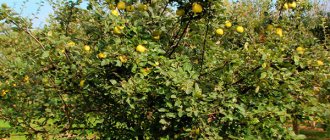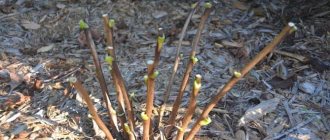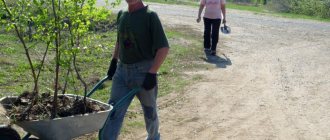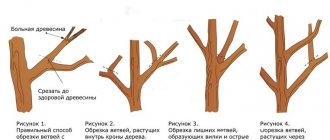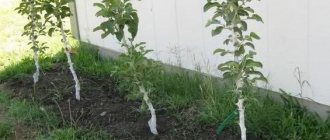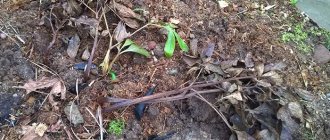For the normal condition of the crown, maintaining immunity and a large number of ovaries on the apple crop, there is one necessary procedure. This is apple tree pruning. Thanks to proper pruning, the plant gains more strength for full fruiting. But just cutting off the branches on an apple tree is not enough; you need to do it correctly and in a timely manner.
The process of pruning an apple tree.
Why is apple tree pruning necessary?
It would seem that the apple tree grows as many shoots as it needs. However, this is wrong. There are several reasons and arguments in favor of the fact that the apple tree really needs this procedure:
- Proper trimming of the crown allows you to form a beautiful shape.
- Due to exposure to the sun, the fruits become more juicy and sweet.
- Good ventilation improves the condition of the crown and minimizes fungal infections.
- An optimally thinned crown of the required height greatly facilitates the gardeners’ task of harvesting.
It is simply physically easier for an apple tree to form fruit if it does not waste energy on a large number of lateral shoots.
Required Tools
In order to properly prune an apple tree, you will need garden shears, pruning shears, a hacksaw and gloves. Usually these familiar tools are enough to shape the crown of an apple tree. If you plan to tie large branches, then you need to use garden varnish to cover the wounds, and if signs of rot or fungal infection suddenly appear, you will need to treat them with a solution of copper sulfate.
Tools you will need to trim an apple tree.
How to prune an apple tree correctly
There are several different schemes and methods for pruning an apple tree: by ring, by bud, or in stages. They are carried out depending on the main purpose and scale of neglect of the apple tree.
On the ring
At the base of each branch there is an annular bead. The ring cutting procedure is carried out diagonally over this bead. It contains many rapidly multiplying cells that help tighten the cut as painlessly and quickly as possible.
An example of cutting to a ring.
If you cut off the branches, but leave the stump, and trim above the overgrowth, then a hollow will quickly form there, and the wound will heal for a long time. And if the ring itself is damaged, then the branch and the entire plant will take a very long time to recover, as if from a severe illness.
On the kidney
If you only need to remove a little of the top of the branches to thin out the crown, you can use bud pruning. For thinning, a bud is left that looks from the middle to the outside of the crown. Sometimes, in order to thicken and make the branches higher, cuts are made the other way around, on the inner bud. After pruning, it is better to wash the resulting wound with a solution of copper sulfate and cover the wound with garden pitch or other suitable insulating agent to prevent infection from getting into it.
Bud pruning.
Step by step pruning
A large branch is cut in several stages, for example, if it has dried out. If you cut it off right next to the trunk, then severe damage to the apple tree is possible.
Thus, you will have to trim the apple trees in several stages:
- At the bottom of the branch near the trunk ring you need to make a small cut halfway through the branch.
- The same cut needs to be made higher on the other side.
- Between these two cuts, make an angled cut.
It is imperative to apply garden varnish to the wound.
Terms of work
The timing of pruning is determined by the needs of the trees, not the gardener. The best time to carry out work is the very beginning of sap flow. Tree pruning begins in the spring from mid-April and continues until the buds break .
Advice! In early summer, it is convenient to carry out sanitary pruning, since it becomes clearly visible which shoot survived the winter and which froze.
During this period, it is easy to identify branches infected with infection or pests. In August, pruning can be done in areas where spring return frosts are common. This will slow down the beginning of the tree’s growing season for the next season and will preserve the fruit buds.
A good time to prune apple trees is autumn, when the leaves and fruits have already been dropped. The main thing is that the air temperature does not drop below ten degrees for the next two to three weeks . In the south, in climates with warm winters, the pruning period can last until February.
Based on the timing of work, methods and types of pruning, you can draw up work plans for different seasons.
Depending on age
Although the pruning technique is the same in theory, depending on how old the apple tree is, there are several differences in how to properly prune.
Upon landing
Usually one-year or two-year-old seedlings are purchased. If you plant annuals, they will take root easier. Two-year-olds can produce crops earlier. You can prune the seedling only after spring planting. This needs to be done at a height of about 80-100 cm. This procedure is important so that it is from this place that the lateral skeletal branches begin to form. If this is not done, then they will go much higher, and the crown will be completely inconvenient to maintain. On a straight trunk, you need to cut off the top above the bud, without leaving a stump.
Scheme for pruning an apple tree when planting.
Young apple trees
All trees under 5 years old are considered young. During this time, each year it will be necessary to cut off the shoots so as to form a crown. It is best to create three or four tiers to make it more convenient to care for the plant and collect fruits from it.
Second year
On the second year apple tree you need to start doing formative pruning. Of the lower branches that will be the tier, you need to leave 3 or 4 and cut them by a third. Skeletal branches will be grown from them in the future.
Leave one central conductor in the center. If several shoots grow there, then they need to be cut off.
Make sure that the central trunk rises 15-20 cm above all branches. The lateral ones are cut to the outer bud so that they grow horizontally.
third year
The third year apple tree is cut in several stages. First of all, the entire length of the side branches is removed by a third. Then the central trunk is cut off, leaving about 40 cm from the starting point of the first tier. From this place shoots will appear that will form the second tier, leaving 3-5 fairly strong branches in each of them.
Fourth year
In the fourth year of life, all side branches that came from last year’s cut also need to be removed at a height of 30 cm. The remaining shoots should be removed by a third. Just like in the previous year, it is necessary to shorten the conductor and side branches. If formulated correctly, the plant will have a well-formed crown. Long shoots are cut to stimulate flowering, and thick ones so that they do not create competition for the guide.
old apple tree
Pruning of an old apple tree is carried out in order to replace non-fruit-bearing branches with young ones on which fruits will form. First of all, you need to choose dry shoots that will be completely removed, but not completely cut off right away. If you cut off a lot of branches, the apple tree will hurt for a long time and may not recover. To remove shoots without leaves, you need to mark them in the summer and gradually remove them.
The best way to do it is this way:
- Shoots that are completely dry are cut into a ring.
- Shoots that thicken the crown and grow inward are cut off.
- Cut the central conductor so that its height does not exceed three and a half meters.
- You need to remove the tops, those shoots that are directed upward, but do not bear fruit.
It is extremely important to prune every 5-6 years and spread it over 2-3 years so that the apple tree does not get too stressed.
If the tree is too neglected, then it will be necessary to prune the shoots gradually over 3-4 years so as not to cause harm.
Types and methods of pruning: which one to choose?
There are usually two pruning options:
- shortening, that is, removing part of a branch,
- thinning, that is, removing the entire branch.
Shortening usually leads to increased growth activity and increased branching of the apple tree. After pruning using the shortening method, at least 3-4 new, strong shoots usually appear.
Thinning allows you to improve the lighting of the center of the crown, increase the ventilation of the crown, and allows you to get rid of diseased shoots that thicken the crown. After thinning, increased growth activity is usually not observed.
In addition, according to the degree of pruning, pruning can be safely divided into 3 categories:
1. Heavy pruning
Typically, this shortens approximately 1/2 of the annual growth, while the remaining shoots are completely removed. This pruning allows you to form a large number of vertical shoots, which you can work with later - bend them to a horizontal orientation and secure them so that fruits appear on them.
Strong pruning is used only when we are talking about very neglected apple trees that have never been pruned, or the pruning was carried out 10 or more years ago.
2. Moderate pruning
Its essence is to shorten half of the annual growth by about 1/3 of the length and remove the remaining shoots. Such pruning usually does not stimulate the formation of tops or only a minimal amount of them is formed.
Apple trees in the orchard that are regularly pruned are usually pruned either lightly or moderately.
3. Cut short
This involves removing approximately 1/4 of the annual growth. Such shoots are shortened by approximately 25%, and a third is removed from the remaining growth. After a year, the shoots usually grow by an average of 15 cm.
It is clear that the first two of the listed pruning options do not apply to young seedlings. Let’s say that if you planted an annual seedling on a plot, then in the first spring it is enough to simply remove its crown, 5-8 cm long, in order to activate its branching.
There are other trimming options:
- Formative pruning begins immediately after planting a standard branched two-year-old seedling, and such pruning usually lasts for 5 seasons after the apple tree is planted on the site. This pruning will allow you to form the so-called crown skeleton.
- Pruning aimed at regulating fruiting is regulatory; it allows you to avoid the acute periodicity of apple tree fruiting, when years with a huge harvest are replaced by one or even a couple of seasons when the apple tree does not produce fruit at all.
- Sanitary pruning , if necessary, such pruning can be carried out in the fall and even in the summer, it is usually not too strong and such pruning is aimed at removing dry, frozen, diseased and broken shoots.
- Restoring - this type of pruning allows you to return a neglected apple tree to its neat crown shape. Typically, such pruning is started in three cases - when the crown is damaged by the wind, when the apple tree is partially damaged by frost, and when the crown is severely neglected due to a complete lack of pruning for a number of years.
- Rejuvenating pruning is usually done on old apple trees, in which growth activity is critically reduced, the crown is severely neglected due to lack of pruning, and severe shrinkage of fruits is observed.
- Annual early spring pruning often includes several of the options described above, and on individual apple trees it may include all pruning options used to varying degrees.
Depending on the time of year
There has long been a debate among gardeners about when to prune. Some are leaning toward spring. It is at this time that plants begin to come back to life. Others say that the procedure should be carried out in the fall, after harvesting. However, these options both exist, but only with some reservations.
Spring
In the spring, apple trees begin to be pruned before the juice begins to move under the bark and the buds swell. Depending on the region, the deadline may shift: from March to April. Be sure to cut off frozen shoots, because they will not bear fruit. They are very clearly visible: if you make a cut, it will be dark in color.
Spring pruning of an apple tree.
At the next stage, remove all branches that grow at an acute angle to the central one. They will not bear fruit, but only take away strength. The same applies to those that grow at an acute angle into the crown. After this procedure of pruning the apple tree, there will be good access of air and sunlight to all its parts.
Summer
In the summer, branches that have grown this year and have not yet become woody are pinched. This is done to slow down their growth.
If you need to prune, you will have to shorten or remove branches that thicken the crown and stand out from the overall picture. It is in the summer that it is very good and convenient to adjust the location of the branches.
In summer, frozen shoots may appear even better. They stand without leaves. They are removed completely if they are small, and partially if their size is large, but be sure to cut them so as to capture the living area.
Autumn
In the fall, young apple trees are cut in order to get a good harvest in the future. In terms of timing, you need to meet the period of time where the leaves have already fallen, but there are still about three weeks left before frost. It is at this time that the wounds will have time to heal.
Scheme for pruning an apple tree in the fall.
You need to remove branches that have bent or cracked under the weight of fruit, and those that grow at an acute angle and are twisted. It is also necessary to remove shoots that have been attacked and damaged by pests, deformed during growth or from exposure to viruses or infections.
Winter
It is believed that in winter the apple tree is dormant and does not need to be pruned. But some gardeners still believe that such a procedure will help the apple tree survive the cold more successfully. Moreover, in winter, the cuts will heal even before the buds begin to bloom, infections and fungi will not enter the cut sites, and the subzero temperature will act as anesthesia, and the apple tree will endure the procedure without stress.
Pruning in winter.
However, there is a limitation: partial cutting of shoots can only be done at temperatures down to -15 degrees. If the frost is stronger, then the branches are too frozen and may break.
In southern regions where there is no severe cold, adjustments can be made at any time during cold weather. But preference should be given to dates closer to the end of winter, and manipulations with the apple tree should be carried out by February.
When is the best time to perform anti-aging pruning?
Rejuvenation begins if the annual growth of the apple tree has become shorter than 20 cm, the skeletal branches and trunk are very bare, and fruiting has “gone” to the periphery of the crown. Anti-aging pruning done in time allows you to limit yourself to a few cuts and cause virtually no harm to the plant.
If the tree is in a very neglected state, then it is best to do rejuvenation after a lean season, when the apple tree has accumulated enough substances for further growth. In a harvest year, the plant can be prepared for subsequent pruning - remove dry branches, clean lichen and old bark from the trunk.
The rejuvenation itself is carried out in the second half of winter, closer to spring. At this time, severe frosts that cause wood to crack are no longer expected, but there are also no thaws. In the southern regions of Russia this is the end of February, in the north - mid-March or even early April.
